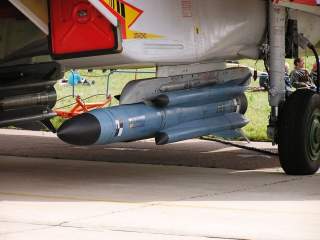Busted: Ukraine Catches Iranian Military Attaché Trying to Smuggle KH-31 Parts out of Kiev
Nice try.
The Kh-31A is an anti-ship missile based on the proven Kh-31P missile. It features an active radar guidance system and a sea-skimming profile.
According Daily Beast, early this year, two Iranians were caught by the Security Service of Ukraine (SBU) in Kiev with parts for the Kh-31 anti-ship missile inside their vehicle.
The items, which included technical manuals, were confiscated and both Iranians were subsequently deported.
This effort appears to have violated a UN arms embargo on Iran.
The incident was described to American government officials by Vasyl Hrytsak, the head of Ukraine’s intelligence service, during a recent trip to Washington.
One of the men, according to Hrytsak, is named Abdi Biyan and was a military attaché at Iran’s embassy in Kiev.
“The diplomats in Ukraine are not there for Chicken Kiev,” said Tom Karako, a fellow at the Center for Strategic and International Studies. “They’re there to get this kind of stuff.”
As explained by Deagel.com, the Kh-31, AS-17 Krypton NATO-codename, is an advanced, long range, highly supersonic missile designed to withstand countermeasures effects. The Kh-31 propulsion system consists of a solid-fuel rocket engine which accelerates the missile to Mach 1.8 airspeed. Then this engine is dropped and a jet engine ignites using the missile’s within space as a combustion chamber. The missile accelerates to Mach 3+ thanks to the jet engine.
The Kh-31A is an anti-ship missile based on the proven Kh-31P missile. It features an active radar guidance system and a sea-skimming profile.
Dr. Nikolai Sokov, a fellow at the Middlebury Institute of International Studies at Monterey and an expert on Russian missiles, said that photos of the missile components shared by The Daily Beast “look consistent” with Kh-31 parts but could not be certain the items in the images came from the Kh-31 given that the “missile is disassembled and the pictures are incomplete.”
“It’s most likely this missile is a Kh-31,” added Behnam Ben Taleblu, a research fellow focused on missiles at the Foundation for Defense of Democracies (FDD), who also reviewed the Ukrainian photos.
“The Islamic Republic is already home to a wide array of Chinese anti-ship weapons and their Iranian variants,” Taleblu said. “Had the Kh-31 been successfully procured, Iran’s ability to project power, harass vessels, and deter great powers in the Persian Gulf would have measurably grown.”
Iranian acquisition of Kh-31 missiles could improve its ability to attack U.S. and Gulf Arab countries’ naval forces as well as commercial maritime traffic transiting the Strait of Hormuz, the thin strip of sea between Iran and the United Arab Emirates that connects the Persian Gulf to the Arabian Sea.
Noteworthy this alleged attempt wouldn’t be the first time Iranians tried to get weaponsfrom Ukraine. In 2005, Ukrainian prosecutors revealed that Iran smuggled Kh-55 air-launched cruise missiles out the country in 2001—a move U.S. officials reportedly believed was assisted by corrupt senior officials in the government of former President Leonid Kuchma. Missile experts believe that the illicitly acquired Kh-55 missiles formed the basis of Iran’s “Soumar” long-range cruise missile revealed in 2015.
Classified State Department cables released by WikiLeaks also show U.S. officials repeatedly warned Ukraine in the mid-2000s that its Zaporizhzhya Regional Foreign Economic Association—sanctioned by the U.S. in 2004—had sold specialty metals useful in the construction of ballistic missiles to Iranian missile procurement front companies.
This article by Dario Leone originally appeared on The Aviation Geek Club in 2018.
Image: Wikimedia

